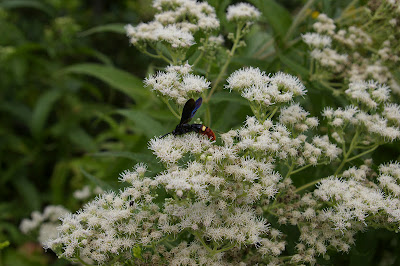Day 200
The Daily DuBrule
I have a giant asparagus patch. Every year I allow 'Grandpa Ott' morning glories to ramble over the six foot tall ferny foliage at this time of year. Of course, I don't plant the morning glories- they come up from seed. 'Grandpa Ott' is a notorious self-seeding heirloom variety that was given to Diane (Ott) Whealy (founder of Seed Saver's Exchange) by her grandfather, Baptist John Ott. It is one of the classic examples of how heirloom seeds that mean so much to the original owners and their descendents can become a garden staple.
Now if you go on line and read about this morning glory, you will find that many people refuse to grow it because it self seeds. My original plants were given to me by my friend Hutch. My courtyard was just completed and it was an empty rectangle of mulch. He had just finished power washing my cedar fence. He gave me a couple of seedlings to crawl on the fence that year. Ever since it has taken residence in my vegetable garden. One year it rambled through the 'Lemon Queen' sunflowers at the edge of the seating wall. Last year it climbed through the magnificent burgundy plumes of amaranth, itself a self sown plant.

I guess I will say, once again, that I am a brave woman allowing all these wonderful wild things into my patch of paradise. But a bright purple morning glory with a ruby red star in the middle that greets me every single morning when I first wander outside? How could I not embrace this plant! I know how to recognize plants I don't need. I am a "take no prisoners" kind of power weeder when I have to be. That's what it takes to have an exuberant, crazy, mixed up garden like mine. I am lovin' it.

















































